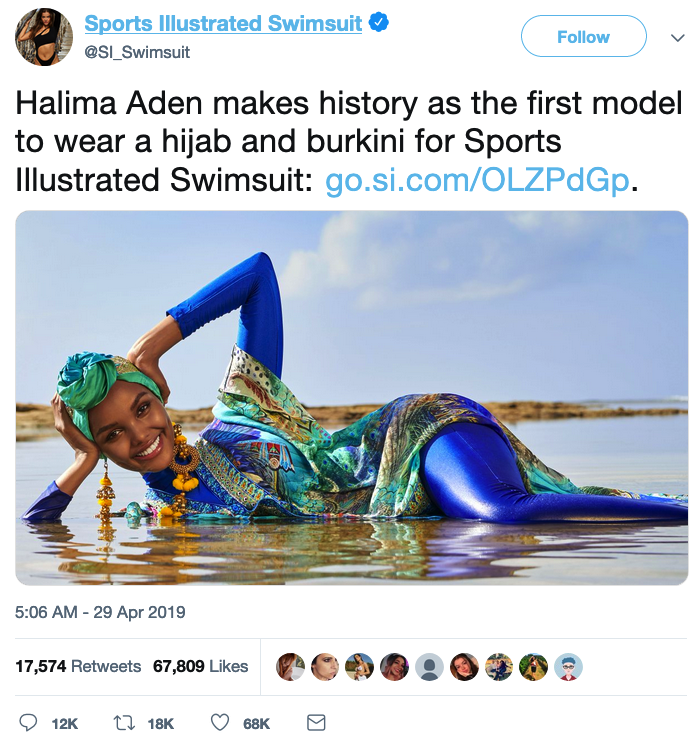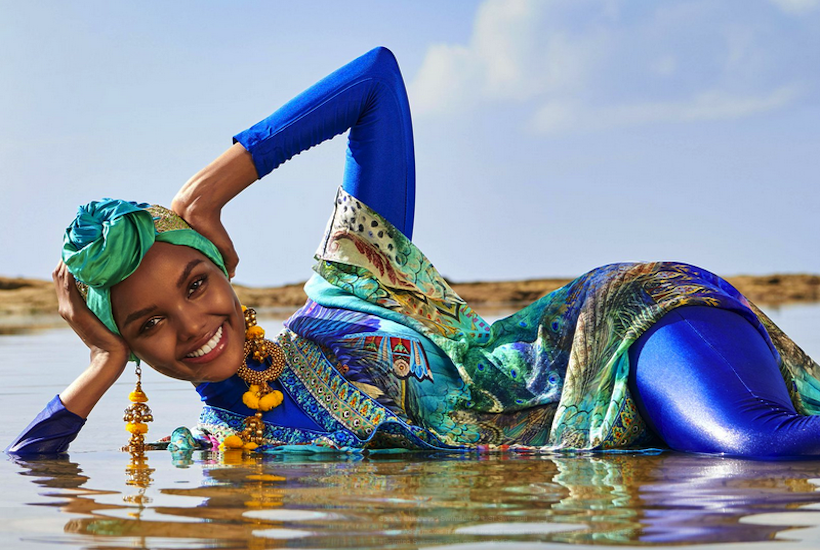In perhaps the most pointless piece of pandering to the gods of diversity and inclusivity, the venerable “Sports Illustrated” swimsuit edition has decided to cover up:
 Well, the event “makes history”, so who are we to argue? Though it’s probably a different historical milestone to the one the editors were thinking about.
Well, the event “makes history”, so who are we to argue? Though it’s probably a different historical milestone to the one the editors were thinking about.
SI explains:
The Somali-American model was born in Kenya at the Kakuma Refugee Camp, where she lived until the age of seven before moving to the United States. For her SI Swimsuit rookie spread, we couldn’t think of a more perfect place travel than her birth country, where she shot at Watamu Beach with photographer Yu Tsai.
“I keep thinking [back] to six-year-old me who, in this same country, was in a refugee camp,” Halima said during her shoot. “So to grow up to live the American dream [and] to come back to Kenya and shoot for SI in the most beautiful parts of Kenya–I don’t think that’s a story that anybody could make up.”
At the age of 19, Halima made headlines when she was the first woman to wear a hijab in the Miss Minnesota USA pageant, where she was a semi-finalist. She went on to sign with IMG models and not only became an incredibly successful international model, but a champion for the expansion of the traditional defintion of beauty as well.
M J Day, the editor of the Swimsuit Edition gushes: “We both believe the ideal of beauty is so vast and subjective. We both know that women are so often perceived to be one way or one thing based on how they look or what they wear. Whether you feel your most beautiful and confident in a burkini or a bikini, YOU ARE WORTHY.”
The rationale for the Islamic “modesty wear” is that women who show any skin apart from hands and face (and sometimes even that) to men who are not their husband or relatives are whores. This, in turn, is because men are animals who are incapable of self-control at the sight of bare female flesh and an uncovered ankle, never mind a midriff, will turn them into instant rapists (husbands, of course, don’t need self-control and male relatives have incest taboos to consider). An “immodest woman” not only endangers her own welfare and virtue but also that of men around her; her reckless disregard of these realities suggests low morals and invites whatever is coming her way.
Aden is free to wear what she likes, and “Sports Illustrated” is free to publish and promote whatever they want, which is sadly not a luxury available to women in countries like Iran or Saudi Arabia, where public “immodesty” (such as removing a head scarf) can be punished with physical chastisement by morality guardians as well as a jail sentence. By splashing a covered-up Aden splashing in water, “Sports Illustrated” is not making any sort of a courageous statement fighting for anyone’s rights and freedoms, because these already exist in the West; if anything it is sending the message to other parts of the world, where such rights and freedoms are non-existent, that what millions of women denied choice consider oppression is actually sexy and enjoys the imprimatur of the enlightened trend-setters.
It is fair to say that no one buys the Swimsuit Edition for the swimsuits but rather for what they leave and don’t leave to imagination. It’s been a publishing institution that thrives on photographing swimsuit models (a collective noun for a group of Leonardo di Caprio’s girlfriends) rolling around the surf and the sand. It’s not a fashion magazine, it’s an opportunity for men to perve on very attractive and very skimpily clothed young women without the shame associated with soft-porn consumption.
For “Sports Illustrated” to have a hijab and burkini clad model makes about as much sense as for “Playboy” to have a burqa covered centrefold. But the absurdity flows in both direction. The whole idea of “modesty wear” and “modesty culture”, of which a burkini is one representation, runs completely counter to the whole ethos of the Swimsuit Edition; you cover up because you don’t want to be ogled by men, whether on a beach or on the pages of a magazine beloved by car mechanics and teenage boys.
Women covering up – or being covered up – does not belong exclusively to Islam, of course. It was practiced with various degrees of success and comprehensiveness by Christians and Jews and many others throughout the ages. The traditional nuns you still see in the continental Europe today remain dressed the way that most women used to be during the Middle Ages.
Some Christian denominations, like the Amish, still maintain strict dress codes, including covering one’s hair (by men too coincidentally). But it’s unlikely that “Sports Illustrated” will ever cover sea-bathing Sisters of Mercy or Amish women who somehow ended up on a beach.
Some modesty is cool while other is not, just like diversity includes some but not others. Only some are destined to “make history”.
Are we feeling empowered yet?
Arthur Chrenkoff blogs at The Daily Chrenk, where this piece also appears.
Illustration: Sports Illustrated.
Got something to add? Join the discussion and comment below.
Got something to add? Join the discussion and comment below.
Get 10 issues for just $10
Subscribe to The Spectator Australia today for the next 10 magazine issues, plus full online access, for just $10.


























Comments
Don't miss out
Join the conversation with other Spectator Australia readers. Subscribe to leave a comment.
SUBSCRIBEAlready a subscriber? Log in